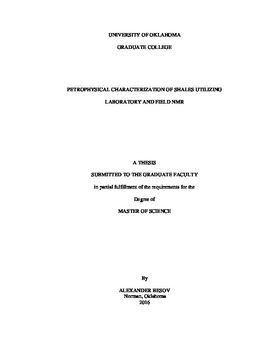| dc.description.abstract | Over the years, service companies designed numerous tools for field NMR measurements. Amongst them are CMR-Plus with Schlumberger, MRIL-Prime with Halliburton and MREX with Baker Hughes. NMR logs found success in application to conventional fields, but their application to shales remains a challenge. An impediment to evaluation is due to confinement of fluids to nanometer pores, organic and non-organic porosity, paramagnetic impurities, as well as limitations of the current logging tools. We evaluated applicability of two of these tools in shales with guidance from the results of the laboratory NMR experiments.
Tuscaloosa Marine Shale, TMS, was logged with a CMR-Plus at 200 fph and 350 fph and Woodford Shale with an MRIL-Prime tool. We conducted 1D as well as 2D laboratory NMR experiments on both shales. Tests were performed at the same echo spacing (TE) as the field logging tools, as well as at TE = 0.114 ms. Measurements were obtained on the as received, cleaned, brine imbibed and pressure saturated (5000 psi), dodecane imbibed and pressure saturated (5000 psi) sample states.
NMR measurements in Woodford shale indicate that storage capacity is underestimated by over 55% with echo spacing ranging from 0.6 ms to 0.114 ms. Service companies attempt to compensate for this by applying extrapolation algorithms to TE = 0 ms. However, we show that extrapolation practices should be conducted with caution. In order to tie NMR results between laboratory and field measurements data should be acquired at the same TE values. Additionally, T2 cutoffs, which are often utilized for the purposes of distinguishing movable and residual fluids, are non-unique and are a strong function of echo spacing. Assuming a T2 cutoff of 0.8 ms, we show on the TMS samples that by varying echo spacing from 0.4 ms to 0.114 ms, movable fluid content was overestimated by 45%.
In TMS, mercury injection and NMR results from imbibition and pressure saturation experiments reveal that the pore network is inaccessible to dodecane due to strong affinity for water and high capillary entry pressure. Vertical fractures are apparent in the NGI image log in addition to microfractures observed in the SEM images. Based on the laboratory measurements, it appears that the TMS matrix cannot store hydrocarbons. Unlike other shale plays, hydrocarbons in TMS are likely stored and produced from the microfractures, rather than from organic or inorganic pore system.
Fluids, confined to the nanometer size pores, were investigated with NMR in the early maturity window of Woodford samples. 1D T2 measurements were not effective in distinguishing brine from low viscosity hydrocarbon (dodecane). T1-T2 signatures of Woodford samples spontaneously imbibed and pressure saturated at 5000 psi with brine and dodecane, as well as NMR response from the non-movable fluids, were obtained with a 2 MHz Oxford-Maran GeoSpec2 spectrometer at TE = 0.114 ms. Samples showed increasing T1/T2 ratio to dodecane following pressurized saturation: dodecane imbibition T1/T2 ≥ 5, dodecane saturation T1/T2 ≥ 10. Small, non-wetting pores are accessed through pressurized saturation, on the order of 4 nm when pressurized with dodecane at 5000 psi. Implications of these finding is such that low viscosity hydrocarbons confined to nanometer size pores experience increasing correlation times or decreasing rotational mobility. Additionally, non-movable hydrocarbons, which remained in the Woodford samples following pressurized cleaning with solvents, showed T1/T2 ≥ 30. Therefore, in nanometer size pores, T1-T2 signatures of low viscosity hydrocarbons and viscous hydrocarbons are likely to overlap. | en_US |
